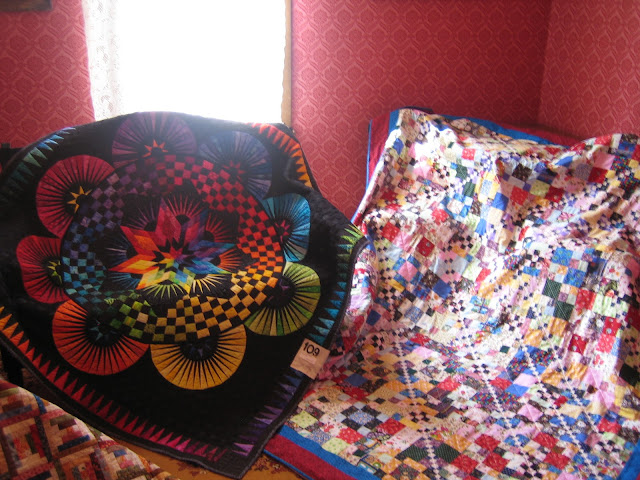This little wall hanging is with an assortment of batik charm squares that I had. The leaf shapes were traced onto fusible web and then ironed on to another 5" charm. The pattern is simple. Just layer two charm squares (good side to good side) drawing a line from one corner to the opposite, then stitch 1/4" to the side of the line you just drew, then stitch down the opposite side. Cut down the drawn line and open so you now have two squares. press the seam open.
(sorry I don't have a photo of that step. Hope this makes sense)
Step One: Using a lightweight fusible web, draw your leaves on the paper side of the web.
Step 2: Cut roughly around the leave shapes. Place the roughly cut leaves onto another 5" charm square, fuse onto the fabric.
Step 3: Let cool and then cut your leave on your traced line.
Step 6: Use a simple zig zag or blanket stitch around the edges of the applique.
Step 7: Once all your squares have their leaves with the stitching completed, then arrange in the pattern you want and stich your squares together. Step 8: and quilt as you normally would. For quilting, I just stitched in the ditch and put my binding on. That's it! It's a great little pattern that has endless possibilities. I liked it because I was able to practice that machine applique. If I screwed up one little leaf...oh well! I tried different fusible webbings as I didn't know which one would be easier to use.
ABOUT FUSIBLES
When you have fused your fabric to one side, you need to peel off the paper from the wrong side as well. You will note this side is dull (as well it feels a bit like there is rubber on the side you are going to fuse to the top of your quilt). The dull side goes down on the top of your fabric.
 |
| Dull Side |
 |
| Good side -- this side is visible |
TIPS: when using your sewing machine to applique the edges, use a new microtek needle. I find these are much sharper and depending on the fusible that you use, will go through the layers without sticking to the needle. If you find your fabric is lifting with the needle, change your needle.
Make sure you allow the fusible shapes to cool off during each step. Do NOT try to sew these on when they are warm -- you don't want the glue from the fusible to gum up the needle or gum up any part of your machine! The fusibles have improved so much over the years. The thinner, the better for virtually invisible applique.
There are lots of uses for the fusible webbing! The Little Man got his "batman cape" from his Nana! (Trust me, the Batman logo is on the back!) The next project is Superman! (this is going to be fussy to cut out! egads!)
Then there are things like Animal Whimsy (an Amy Bradley design):
Think about the final look that you want when you are using fusible applique. You can have messy edges that will fray after many washings by using a straight stitch on the edge. If you want it to pucker after a wash -- it won't, it will remain fairly smooth. The thinner, the less "crisp" the final finish is. Experiment and see what you like.Do you have any other creative uses for fusibles? Happy Quilting! (or should I say Fusing???)

















































